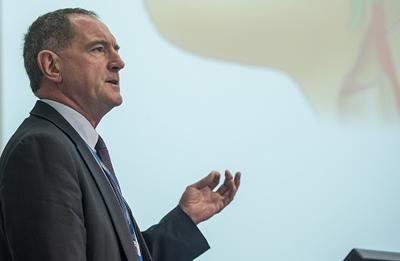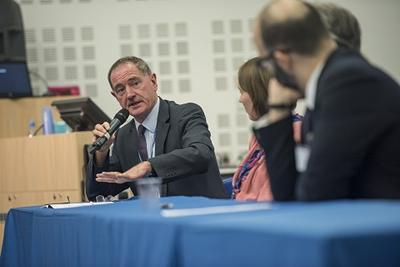NAMRIP helps secure £15 million for Southampton

NAMRIP has helped secure a £15 million award from the National Institute for Health Research (NIHR) for a new NIHR Biomedical Research Centre (BRC) at the University.
The new Centre will have ‘horizontal’ themes in microbial, behavioural and data science that will feed into ‘vertical’ disciplines of nutrition and respiratory/critical care. The successful proposal described its microbial science theme as follows:
‘We have made key discoveries in the role of the microbiome in development and in metabolic, gastrointestinal and respiratory health. Our EPSRC-funded Network for Antimicrobial Resistance Infection Prevention has brought engineering solutions to address antimicrobial resistance in hospitals, such as use of specialised materials and ultrasonic disinfection to prevent hospital-acquired infection. Our work using novel vaccines to inhibit nasopharyngeal carriage, and thereby enhance herd protection, has been used by the Joint Committee for Vaccination and Immunisation as evidence for the deployment of the new meningitis vaccine into the childhood schedule...
...Microbial Science will exploit our dual strengths in microbiome research and Experimental Human Challenge to explore the benefits of microbiome modification for patients, and generate engineering solutions for antimicrobial resistance by partnership between UHS and physical scientists across UoS (via our EPSRC funded Network for Anti-Microbial Resistance and Infection Prevention)...
... The BRC strategy is to enable clinician engagement with NAMRIP scientists across engineering, physical and social sciences to rapidly translate AMR solutions to the NHS.’
This is tremendous recognition of the NAMRIP concept by the National Institute of Health Research. The award will strengthen further our capacity to apply basic science discoveries made by Southampton physical scientists to the problem of AMR in patients in our hospitals
It was a pleasure to work on this bid, and I am especially grateful to Rob Read, who put in such a tremendous amount of work and will be a superb leader for the initiative – he is a fantastic researcher, with a profound understand of the breadth of issues covered by the BRC. This is a great conclusion to NAMRIP’s first year

The Director of the new BRC will be NAMRIP member Professor Rob Read, who has been part of NAMRIP’s Steering Committee from the start, and is Professor of Infectious Diseases and Honorary Consultant Physician to Southampton University Hospital.
The bid cited a wealth of AMR work, from NAMRIP members including Timothy Leighton , Robert Eason, Hywel Morgan, James Wilkinson, Bill Keevil, Jeremy Webb, Saul Faust, Tristan Clark, Mary Carroll, Paul Elkington, Tom Wilkinson, Mandy Fader, and Kieran Hand.
Notes for editors
‘In one year NAMRIP has gone from an initial £10k startup funding as a University Strategic Research Group (plus the immeasurable value of Frances Clarke’s admin support) to see its members win over £4.2M of research funding and receive 7 PhD studentships (mainly with industry support, indicative of our drive in translating fundamental research through to benefits for society). It is great to finish the year with this BRC win for Southampton to see such a stunning collaboration between the University and the Hospitals, to undertake exactly the translation NAMRIP was designed to do.
We appreciate our income, but we value our efficiency (the ratio of outputs to the income we receive), and to keep our efficiency high we know that income wins like this must drive us to make a real practical difference to societal problems from our fundamental research. The strength of NAMRIP is in the outputs that power up the top of the efficiency fraction. We have brought together engineers, chemists, microbiologists, environmental scientists, veterinary and human medics, clinicians who contribute to international and national antibiotic guidelines for specified conditions, experts in food, ethics and law, crucially networked with economists, geographers, health scientists and experts from other social science disciplines to provide a truly joined up approach to AMR and Infection Prevention (offsetting the loss of diversity in pharmaceutical industry research teams). Our members have produced almost weekly journal publications and formed exciting new research collaborations, plus we have changed the world outside academia, engaging with the public, and we have now begun translating our inventions into the wider world with the first of our inventions tested in hospitals across the UK. In this first year we have hosted two fantastic conferences plus a pan-UK AMR leaders meeting and seen our members win numerous prizes and awards. My favourite web page is our news page, with almost weekly developments. We have ended the first year with the launch of Global-NAMRIP (to work with low/middle income countries in tackling AMR and find effective interventions supporting vaccination and infection prevention) and now crowning our first 12 months we have this NIHR/BRC win. What a year!
The BRC will support translation into healthcare of the ideas that NAMRIP researchers come up with. This is vital. We are half-way through the 2-year EPSRC network support that has enabled us to hire our Programme Manager, Yvonne Richardson who has given so much to managing this network successfully, and which has enabled us to formed the vital community that is NAMRIP. Our funding ends in 2017, and it is far too early to say the vitality of so many ideas must crystallize into one or two large research projects that replace this community. It cannot be overemphasized that we do not know what the solution to AMR will be, and so we must maintain network funding to ensure we keep in the EXPLORATION phase, and not jump prematurely to the CRYSTALLIZATION phase where all the funding is devoted to one or two large research projects. We must not deprive of funding the ‘soup’ of brilliant and inspired ideas that the NAMRIP research community generates, and translatse into society with the benefit of our partners. The overwhelming challenge for NAMRIP is to keep that soup bubbling beyond 2017.’
Professor Timothy Leighton, Chair of NAMRIP